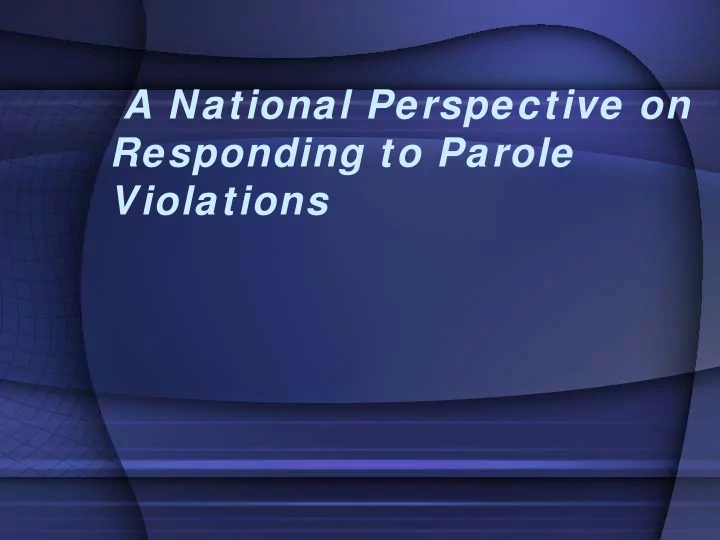

A National Perspective on Responding to Parole Violations
Responses to Parole Violations Traditionally…. • Very little attention or visibility • Very little policy • Great discretion on the part of parole officers • Monitor offenders…when the PO thought it appropriate, bring the violator back to the Board
Attention has become more intense… • Growth in prison populations • Growth in the number and proportion of admissions to prison as a result of parole revocation—doubling between 1992 and 2002 • Growth in the parole population—which is “at risk” of return to prison
Figure 1: Trends in Release from Federal and State Prisons and Returns for Violating Parole or Other Conditions 700,000 600,000 500,000 400,000 300,000 200,000 100,000 0 0 2 4 6 8 0 2 4 6 8 0 2 8 8 8 8 8 9 9 9 9 9 0 0 9 9 9 9 9 9 9 9 9 9 0 0 1 1 1 1 1 1 1 1 1 1 2 2 Offenders Released Offenders reincarcerated for violating parole or other release conditions
Early Focus on Responses to Violations... • Work with parole boards on release decisionmaking led to a focus on violations and revocations—by the early 1990’s --8 states • Focus was primarily on: – Consistency – “Intermediate” sanctions for violations – Objective scales to assess severity and risk – Responses mostly about consistency and proportionality – Goals: accountability and incapacitation
Today, the Trend is Tow ard Evidence-Based Violation Decisionmaking • Responses designed to REDUCE risk, not simply manage or contain risk • Looks to the principles of evidence-based practice to identify responses at a level of intensity and intrusiveness that corresponds to level violation severity, offender risk AND need • Goal is to reduce the likelihood of reoffending—not only to contain the risk
Additional Information • Innovations • Tools/Practices/Strategies • Implications for Supervision • Summary of “new direction”
Examples of Innovations in Other States • Kansas—mounting a state-wide “risk reduction” initiative that began with a focus on the parole population and reducing returns to prison for technical violations, and reducing the incidence of criminal violations • Georgia—using specific “tracks” of parolees based on assessed needs and giving parole officers tools to measure progress (among 8 other TPC States) • New Jersey—focusing supervision on criminogenic needs, structured guidance for parole officers
What Types of Tools, Practices • Scaling of violation behavior—shared understanding of the importance of various types of non-compliance • Use of empirically-based risk assessment tools to identify risk of parolee • Case plans that identify specific programs, interventions appropriate to a parolee’s criminogenic needs—interventions can be drawn from these • Categories of “responses” from which parole officers select appropriate actions for a specific parolee, violation, level of risk and need • Clarity about when a PO has discretion, when a Supervisor must approve
Parole practitioners… • Have come to understand the limitations of incapacitation as a response to violations; • Are in the process of putting in place new practices that: � Expect compliance and hold offenders accountable; � Scale responses based upon severity of the violation and risk of the parolee; � Seek to enhance successful completion of parole and reduced victimization; � Use the principles of evidence-based practice
This means….w e are moving • From risk management—surveillance, containment, incapacitation • To risk reduction—taking actions to reduce risk, focusing on high-risk offenders and their criminogenic needs
For parole supervision… • It’s not just about monitoring compliance and returning the non- compliant….it’s about using responses targeted by risk…to REDUCE future offending.
Parole supervision has a critical role to play in responding to violations… • Authority over the critical period just after release • Tools of parole lend themselves to using the lessons of research to increase success—target by risk • Critical “pressure point” of the system
Current interest is on: • Successful reentry including reductions in recidivism, and • Responses to violations that enhance public safety by using resources wisely and using interventions associated with reductions in recidivism
We see practice emerging to: • Develop and use research-based decision tools • Target interventions by risk and need— for both high and low risk offender • Create incentives for successful reentry • Set and manage conditions for SUCCESS • Targeted, problem-solving approaches to violations
Key Messages • A successful strategy to respond to parole violations is about public safety and is a core mission for parole; • The lessons of research provide important guidance
Recommend
More recommend